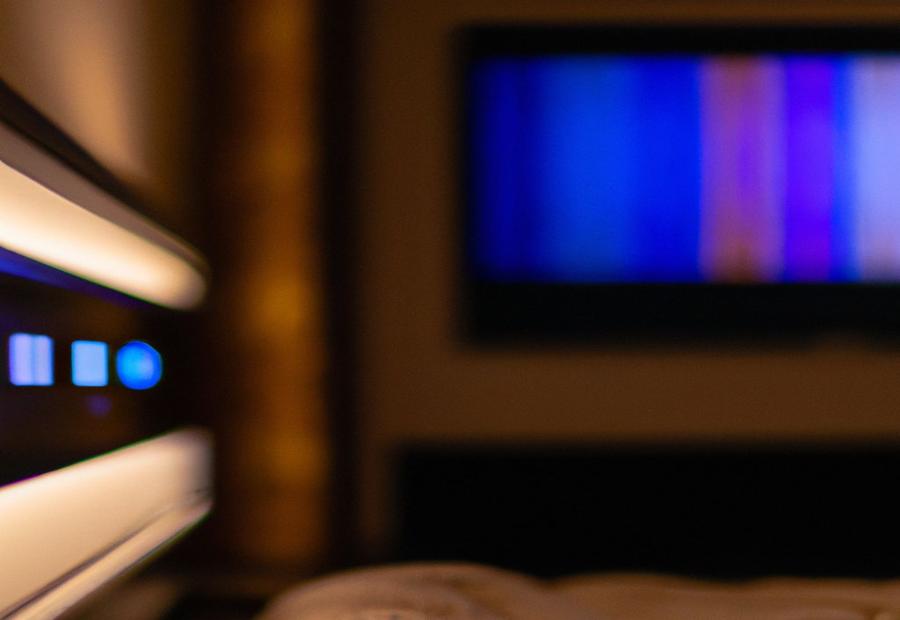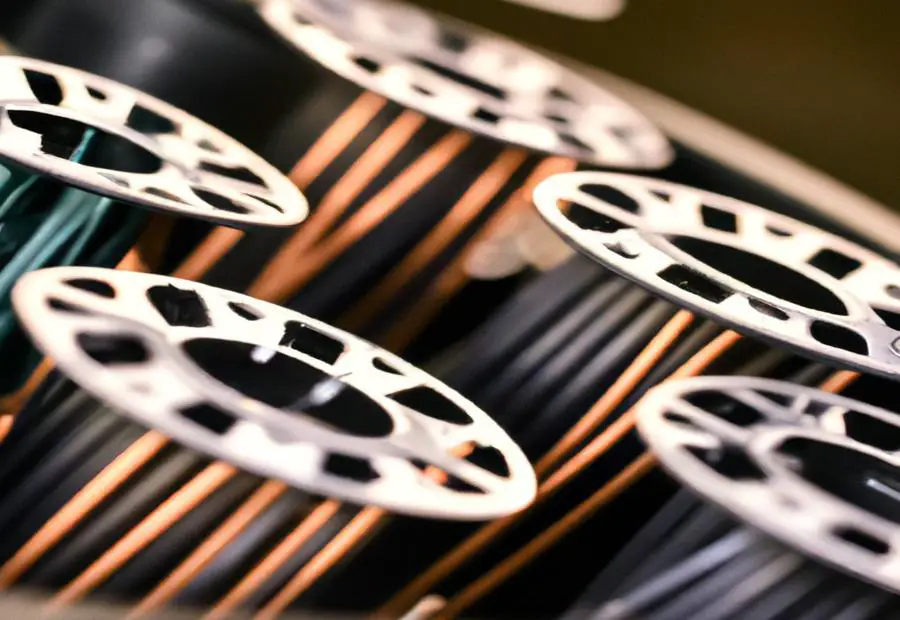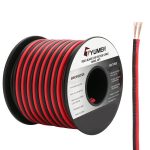Last Updated on 10 months by Francis
.jpg)
Using Thermostat Wire for LED Lights: Compatibility and Considerations
When it comes to wiring LED lights, it’s essential to choose the right type of wire to ensure safe and efficient operation. One question that often arises is whether thermostat wire can be used for LED lights. In this article, we will explore the suitability of thermostat wire for LED lighting applications and discuss alternative wiring options.
Thermostat wire is commonly used for connecting heating and cooling systems, as it is designed to handle low voltage and control signals. It typically consists of multiple solid copper conductors enclosed in a PVC jacket. However, before considering using thermostat wire for LED lights, it’s crucial to understand its properties and limitations.
Thermostat wire differs from other types of wires, such as electrical wires used for power distribution. It is not intended to handle high voltages or heavy currents. Thermostat wire is typically not designed to withstand the constant movement and flexing that may occur in lighting installations.
To determine whether thermostat wire can be used for LED lights, compatibility is a key factor to consider. LED lights typically require low-voltage DC (direct current) power, while thermostat wire is often used for low-voltage AC (alternating current) applications. While it may be possible to use thermostat wire for LED lights in some cases, it is recommended to consult the manufacturer’s specifications and guidelines to ensure compatibility.
There are considerations to keep in mind when using thermostat wire for LED lights. These include assessing the power requirements of the LED lights, understanding the length and gauge of the wire needed, and determining the load capacity of the wire to avoid excessive voltage drop or overheating. It is also important to assess the environmental conditions and ensure adequate insulation and protection for the wiring to prevent any damage or hazards.
In some cases, alternative wiring options may be more suitable for LED lights. These options can include using specialized LED-compatible wires, such as low-voltage landscape lighting wire or stranded copper wire designed for low-voltage lighting applications. These wires are specifically designed to handle the electrical demands and environmental conditions associated with LED lighting systems.
Considering the benefits and drawbacks of using thermostat wire for LED lights is essential. While it may offer a cost-effective solution for certain low-voltage applications, it may not provide the optimal performance or durability required for LED lighting systems.
Contents
Key takeaway:
- Using thermostat wire for LED lights can be problematic: Thermostat wire is not specifically designed for use with LED lights and may not provide the necessary power and compatibility.
- Consider alternative wiring methods for LED lights: It is recommended to use wiring methods specifically designed for LED lights to ensure proper functionality and safety.
- Thermostat wire may have limitations for LED lights: While thermostat wire can be used in certain situations, it may have drawbacks such as limited capacity or potential for overheating.
Understanding Thermostat Wire
When it comes to installing and using thermostats effectively, understanding thermostat wire is crucial. Here are some key points to consider:
- Thermostat wire plays a specific role in connecting thermostats and HVAC systems.
- It consists of solid copper conductors with a protective non-metallic jacket.
- Different gauge sizes, such as 18, 20, or 22 AWG, determine the thickness of the wire.
- Selecting the appropriate gauge size is essential for proper functionality of your thermostat and HVAC system.
- Color-coded insulation on thermostat wire allows for easy identification of different wires.
- Properly understanding the wiring configuration and color-coding is crucial when connecting the thermostat to the HVAC system.
- For guidance on thermostat wire selection and installation, it is recommended to consult the manufacturer’s instructions or a professional electrician.
- Accurate operation of the thermostat and efficient functioning of the HVAC system rely on proper installation of the thermostat wire.
- Using the wrong wire type or incorrect installation can result in malfunctions or damage to the thermostat or HVAC system.
What is Thermostat Wire?
Thermostat wire, also known as low voltage control wire, is a specialized type of wire that is exclusively used for thermostats and other low voltage control systems. This wire is particularly designed for heating, ventilation, and air conditioning (HVAC) systems to establish a connection between thermostats and the heating and cooling equipment.
How is Thermostat Wire Different from Other Wires?
Thermostat wire is different from other wires in several ways:
- Composition: Thermostat wire is typically made with solid copper conductors, which provide good conductivity and durability.
- Gauge: Thermostat wire is often smaller in gauge compared to other wires, such as electrical wires used for higher voltage applications. The smaller gauge allows for flexibility and easier installation in tight spaces.
- Incorporation: Thermostat wire is typically insulated with a specific type of material that is resistant to temperature fluctuations. This insulation helps protect the wire from damage and ensures proper functioning in environments with varying temperatures.
When choosing thermostat wire for LED lights, it is essential to consider these differences and ensure compatibility and safety.
Suggestions:
- Check wire gauge requirements: LED lights may have specific gauge requirements for wiring. Make sure the thermostat wire you choose meets or exceeds the required gauge to ensure proper functioning and avoid issues like voltage drop.
- Consider insulation material: Although thermostat wire is typically insulated for temperature fluctuations, it may not provide the same level of protection as wires specifically designed for LED lights. It is advisable to use wires with insulation designed for LED lighting applications.
- Consult a professional if unsure: If you are unsure about the compatibility or safety of using thermostat wire for LED lights, it is best to consult an electrician or professional in the field. They can provide guidance based on your specific needs and ensure proper installation.
Can Thermostat Wire be Used for LED Lights?

Photo Credits: Infraredforhealth.Com by Kevin Hill
Can thermostat wire work with LED lights? Let’s dive into the compatibility and considerations of using thermostat wire for LED lights. Discover the surprising facts and practical tips that will help you make an informed decision when it comes to wiring up your LED lighting system. Don’t miss out on the essential insights that will ensure a smooth and efficient connection between your thermostat wire and LED lights.
Compatibility of Thermostat Wire with LED Lights
Compatibility of Thermostat Wire with LED Lights
|
Thermostat wire can be used for low-voltage LED light applications. |
|
Thermostat wire is typically made of solid copper conductors and is designed to handle low voltage and low current applications. |
|
LED lights operate on low voltage and low current, making them compatible with thermostat wire. |
|
It is important to ensure that the thermostat wire used is appropriate for the voltage and current requirements of the specific LED lights being used. |
|
Consult the manufacturer’s specifications for the LED lights to determine the appropriate wire gauge and current carrying capacity. |
|
Using thermostat wire that is not suitable for the voltage and current requirements of LED lights may result in improper functioning or damage to the lights. |
Considerations When Using Thermostat Wire for LED Lights
When considering the use of thermostat wire for LED lights, it’s important to keep in mind the following considerations:
- Wire Gauge: Take into account the power requirements of your LED lights and ensure that the thermostat wire gauge is suitable. It needs to handle the current without causing voltage drop or overheating.
- Insulation: Verify that the insulation of the thermostat wire is rated for the voltage and temperature conditions of the LED lights. This is crucial for safe and reliable operation.
- Length: Take into consideration the necessary wire length for your LED light installation. If the wire is too long, it may result in voltage drop, impacting the light’s performance. Calculate the appropriate wire length to maintain optimal brightness.
- Compatibility: Make sure that the thermostat wire is compatible with the specific type of LED lights you are using. Different LED lights have different power requirements, so it’s essential to choose wire that can handle those requirements.
- Installation: Follow proper installation techniques to securely connect the thermostat wire to the LED lights. This will help prevent any loose connections or potential hazards.
Pro-tip: If you’re unsure about the suitability of thermostat wire for your LED lights, it’s recommended to consult an electrician or a knowledgeable professional for a safe and efficient installation.
Alternative Wiring Options for LED Lights
Looking to explore alternative wiring options for your LED lights? In this section, we’ll dive into the recommended wiring methods specifically designed for LED lights. Additionally, we’ll discuss the benefits and drawbacks of using thermostat wire for your LED lights. Whether you’re seeking efficient installation techniques or considering unconventional wiring options, we’ve got you covered! Get ready to discover the best ways to power up your LED lights in a safe and reliable manner.
Recommended Wiring Methods for LED Lights
| Recommended Wiring Methods for LED Lights |
|
1. Use appropriate gauge wire: It is recommended to use 18-gauge wire for most LED light installations. This gauge is suitable for the typical low voltage and low current requirements of LED lights. |
|
2. Install proper connectors: Ensure that you use high-quality connectors that are compatible with the size of the wire used. This will provide a secure and reliable connection for your LED lights. |
|
3. Use separate wires for power and control: It is best to have separate wires for power and control signals when wiring LED lights. This helps to avoid any interference or voltage drops that can affect the performance of the lights. |
|
4. Follow manufacturer’s guidelines: Always refer to the manufacturer’s instructions and guidelines for the specific LED lights you are using. They may provide specific recommendations for wiring methods to ensure optimal performance and safety. |
|
5. Consider using a LED driver: LED drivers can regulate the current and voltage supplied to the LED lights, ensuring stable and efficient operation. They can also protect the lights from power surges and fluctuations. |
|
6. Secure and protect the wiring: Properly secure and protect the wiring to prevent any damage or accidental disconnections. This can be done using cable ties, conduit, or other suitable methods. |
Benefits and Drawbacks of Using Thermostat Wire for LED Lights
The benefits and drawbacks of using thermostat wire for LED lights are as follows:
- Benefits:
- Compatibility: Thermostat wire can be used for LED lights as it is capable of carrying low voltage electrical currents, which is suitable for powering LEDs.
- Ease of installation: Thermostat wire is typically easy to work with due to its flexibility and familiar wiring connections.
- Cost-effectiveness: Thermostat wire is generally affordable and readily available, making it a cost-effective option for wiring LED lights.
- Reliability: When properly installed, thermostat wire can provide a reliable connection for powering LED lights.
- Drawbacks:
- Limitations in length: Thermostat wire is typically available in shorter lengths, which may not be suitable for longer distances between the LED lights and the power source.
- Low voltage limitations: Thermostat wire is designed for low voltage applications, so it may not be suitable for higher voltage LED lights or installations that require a higher power capacity.
- Lack of insulation: Some thermostat wires may not have sufficient insulation to protect against electrical interference or environmental factors, which could potentially affect the performance and lifespan of the LED lights.
Considering the benefits and drawbacks, it is important to assess the specific requirements of your LED lighting installation. If you have a small-scale installation with short distances and low power requirements, thermostat wire can be a suitable and cost-effective choice. However, for larger installations or those with higher voltage needs, exploring alternative wiring options may be beneficial to ensure optimal performance and safety of your LED lights.
Additional Resources

Photo Credits: Infraredforhealth.Com by Joe Ramirez
Here are some additional resources that can provide further information on the topic:
- The Electrical Technology website offers a detailed guide on installing LED light strips, including information on wiring.
- For a comprehensive understanding of LED technology, visit the Energy.gov website, which provides in-depth information on the benefits and installation of LED lights.
- The LED Supply blog provides step-by-step instructions and diagrams on how to wire LED lights, ensuring a safe and effective installation.
- If you prefer video tutorials, the YouTube channel “Ultimate Handyman” has a detailed video on wiring LED lights, offering visual guidance for a successful installation.
- If you have specific questions or need assistance with wiring LED lights, consider joining an online community, such as the DIY Stack Exchange forum, where experts and enthusiasts can provide guidance and share their experiences.
Some Facts About Can You Use Thermostat Wire for LED Lights:
- ✅ When installing LED lights, it is important to use the appropriate wiring such as Chapter 3 method or specially listed Class 2 power supplies. (Source: Mike Holt)
- ✅ Using small gauge wire, like thermostat wire, for LED light installation is not advisable as it can result in a significant voltage drop. (Source: Mike Holt)
- ✅ A 12-volt LED lighting system has 10 times more current than a system operating at 120 volts. (Source: Mike Holt)
- ✅ Solid 18/2 thermostat wire may not be suitable for LED strip lighting as it may lack the necessary insulation and other features of dedicated LED wiring. (Source: Reddit)
- ✅ LED strip lighting may have specific requirements or special features that are not present in generic thermostat wire. (Source: Reddit)
Frequently Asked Questions
Can you use thermostat wire for LED lights?
Using thermostat wire for LED lights is not advisable, especially when installing an in-wall lighting system. The small gauge wire, such as thermostat wire, can result in a significant voltage drop, negatively impacting the lighting performance.
Is it recommended to use small gauge wire, like thermostat wire, for connecting LED strips?
No, it is not recommended to use small gauge wire, like thermostat wire, for connecting LED strips. The small gauge wire can lead to a voltage drop, which can affect the performance of the LED lighting system.
What is the impact of using small gauge wire with LED strips?
Using small gauge wire with LED strips can result in a significant voltage drop. This voltage drop can lead to diminished brightness and performance of the lighting system.
What is the recommended method for installing a power supply for LED lights?
The recommended method for installing a power supply for LED lights is to use a Chapter 3 method, unless the power supply is specifically listed as Class 2. This ensures safe and efficient power delivery for the LED lighting system.
Is it safe to use regular 18/2 wiring with in-wall PVC insulation for LED in-wall lighting?
Yes, it is safe to use regular 18/2 wiring with in-wall PVC insulation for LED in-wall lighting. However, it is important to consider the voltage drop and performance implications of using small gauge wire like 18/2 for longer distances.
Can solid 18/2 wire be used for connecting LED strips?
Yes, solid 18/2 wire can be used for connecting LED strips. It has lower resistance compared to stranded wire and can be a suitable choice. However, it is important to consider the distance between the LED strips and the voltage drop that can occur.



.jpg)
.jpg)



